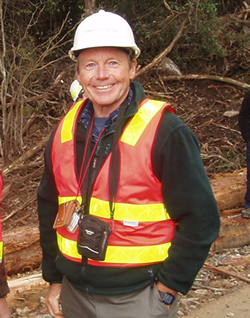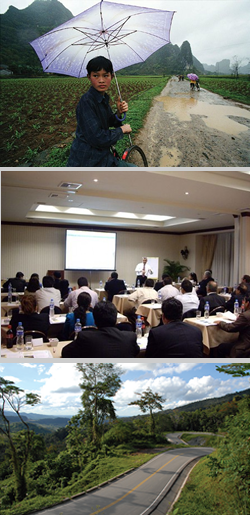
When it comes to rural road design, Gordon Keller has seen firsthand quite a bit of what the world has to offer. A licensed civil and geotechnical engineer in California, Mr. Keller has worked since 1972 for the US Forest Service and played a key role in numerous international training courses, engineering evaluation missions, and conferences. He’s co-led workshops in the Sudan, conducted rural road and environmental analysis throughout Latin America, and worked with the World Bank, the Pan-American Highway Institute, the Rainforest Alliance, and many other organizations. He has also worked closely with the International Road Federation (IRF), a non-governmental, not-for-profit organization dedicated to promoting the development and maintenance of better, safer and more sustainable roads and road networks.
Keller will lead an IRF Executive Seminar on Rural Roads 11-13 April 2012 in Orlando, Florida on the subject of “Low-Volume Roads Engineering (Best Practices).” Joining him in Orlando will be guest instructors Alan Kercher, P.E. (President, Kercher Engineering) and Ben Gericke* (Program Team Leader, Europe and Central Asia Sustainable Development, The World Bank). Major topics at the Executive Seminar will include slope stability, road drainage, geosynthetics, planning, design, erosion control, and more.
With his extensive experience in slope stability, retaining structures, subsurface investigations and other primary intersections between geotechnical engineering and geosynthetic technologies, Geosynthetica asked Mr. Keller if we might pick his brain about some of the issues involving rural roads, low-volume roads and international practices. We thank him for sharing his time and thoughts with us…especially since we caught him on vacation.
– Chris Kelsey, Editor
**
 WHAT International Road Federation Executive Seminar, “Rural Roads – Low Volume Roads Engineering (Best Practices)” WHEN 11-13 April 2012 WHERE Orlando, Florida Wyndham Lake Buena Vista Resort WHO Civil engineers, road managers and resource specialists involved in the design and maintenance of rural roads |
IRF’s “Safer Roads by Design™” program cites a number of World Health Organization (WHO) statistics and notes how simple, lower-cost engineering approaches can positively impact the safety of roads. Is this an aspect of rural road (and low-volume road) engineering that your Orlando workshop will address? What are some of the lower cost options?
Low-volume roads (LVR) safety is a big issue these days, both in the US and worldwide. Statistically for miles driven, there are more accidents on LVR than higher standard roads. In India, traffic accidents are the second-leading cause of death. As a Geotechnical Engineer I have never explicitly dealt with traffic safety much, but as time goes on I am incorporating more and more information on safety. It will not be a major part of the workshop, but we will address it in the discussions on road design.
Today a lot of emphasis is given to road safety audits to identify particularly dangerous locations; design consistency; the need for good signs where road standards change or for narrow spots; traffic control signs in area of road work to protect the workers; use of safer guardrails on higher speed LVR, etc.
Have you been involved in any the Geosynthetic Reinforced Soil – Integrated Bridge System (GRS-IBS) projects? The Federal Highway Administration (FHWA) is pushing this considerably today, and it is helping convince more county engineers, for example, who often have heavy LVR responsibilities, to look at the numbers and adopt techniques like this.
Yes, I think GRS bridge abutments are a great innovation and very appropriate technology for low-volume roads. The Forest Service has built a number of them over the past 20 years and I wrote a paper on GRS Bridge Abutments for a past TRB International LVR Conference. I was also on the initial NCHRP Panel working with Dr. Wu in Colorado that lead to NCHRP Report 556 on design of GRS structures. Current research is now focused on seismic performance of GRS abutments. We have worked with Mike Adams (FHWA) on these structures and think the GRS-IBS is a great candidate for their “Every Day Counts” initiative.
It is an underutilized technology and needs all the push we can give it. Structural Bridge Engineers are very conservative, so it has been a challenge to sell them on the concept. There are valid concerns about foundation scour in dynamic stream channels. The work in Defiance County (Ohio) and other counties is validating the cost and time savings of the technology. I will discuss it briefly in the workshop.

Agriculture is inevitably wrapped up in rural roads and LVR discussions. Have changing practices in farming affected the way rural roads and low-volume roads must be thought of and (re)designed?
A big issue today is not only farming but energy development all over the country that is putting more, larger, and heavier vehicles on the roads than traditional uses. Ethanol production is taxing rural farm roads, while oil and gas development are damaging roads in the east (Pennsylvania) and the Midwest. Wind farms and their construction pads, hauling turbines, etc. are taxing many rural roads nationwide.
People are struggling with designs and solutions. They require thick structural sections on many soils, use of strong geogrids for reinforcement in soft areas, and a lot more maintenance. The mechanisms for funding and for doing more road maintenance are key issues to many road managers (and unfortunately many of the developers are not paying enough to cover the damage).
The erosion control field has grown significantly in the past decade, with ever-increasing regulations requiring “BMPs”. What sort of recommendations (if any) might you have to help engineers ensure that the Best Management Practices they choose really are “best” for them?
The area of erosion control is probably one of the fastest growing areas for use of geosynthetics, including rolled EC products, turf reinforcement mats (TRMs), geocells, silt fences, etc. In this country, it has become an art with a lot of “designer” products on the market. For instance, geosynthetic netting products are available today that will decompose in given amounts of time. One should choose reliable contractors with a good track record for applying appropriate techniques. The IECA (International Erosion Control Association) offers a lot of good advice.
In most foreign countries, the basic challenge is just applying basic erosion control in construction projects. Control of drainage and providing ground cover are the two key issues. Vegetation, and particularly deep-rooted vegetation, is key to good long-term erosion control and slope stabilization in many countries, often combined with soil bioengineering and biotechnical treatments. Biotechnology is under-utilized on LVR in most countries, including America.
Another (still) hot topic in engineering is sustainability and the increasing attention paid to how greener construction practices really can make enormous economic sense. What are some ways that LVR / rural roads can be designed and constructed with sustainable engineering goals in mind?
Overall one of the most important environmental mitigations to avoid many problems is just the application of good engineering design, coupled with good planning and an environmental consciousness. So many failures and associated environmental impacts I see in various countries are just due to bad designs or no design. However, sustainable practices involve application of good long-term planning and design, such as drainage structures that are designed to last their design life (25-100 years); more concern for road drainage and protection of water quality (applying BMPs); use of local materials and labor pools whenever possible; incorporating local resources and community involvement in road maintenance activities; applying inspection and quality control so aggregates, geotextiles, and concrete meet specifications and achieve their design life; more utilization of vegetation, soil bioengineering, and biotechnical measures in erosion control and slope stabilization; etc.
Geosynthetica’s readers are certainly interested in the geosynthetic aspects of LVR engineering. What geosynthetic materials and construction techniques will you profile during your workshop?
We will address the use of geosynthetics in a number of different applications, and I have a lot of photos of geosynthetic applications clear through the different topics. Geosynthetics have been used in our Forest Service low-volume roads for 35+ years now. Applications include filters and drainage in underdrains; subgrade separation and reinforcement over soft soils; for reinforcement in reinforced soil slopes and MSE (Mechanically Stabilized Earth) walls, particularly our geotextile walls (sometimes fondly referred to as “burrito” walls); and in many applications for erosion control. In LVR there are many applications for geosynthetics, but overall use is small.
What are some of the LVR approaches being utilized elsewhere and that can provide American engineers with strong, supportive examples to influence their thinking?
Again, in developing countries, similar to America, the appropriate application of basic engineering principals and environmental mitigations in road work is key for doing good work. In developing countries, you find really good and creative use of local materials and ways of getting work accomplished. Many would not meet US standards, but work. There is a definite lack of environmental consciousness in many developing countries, so road training is important to promote long-term cost- effectiveness along with environmental awareness and protection. I greatly appreciate the quality of our environment, clean water and air, and lack of trash along roads in America after working in other countries. We need to pass that environmental awareness on to other countries.
**
The International Road Federation (IRF) Executive Seminar on Rural Roads (“Low-Volume Roads Engineering (Best Practices)”) will take place 11-13 April 2012 in Orlando, Florida at the Wyndham Lake Buena Vista.
* NOTE: Since this interview was conducted, the World Bank’s Ben Gericke has changed position within the organization. A colleague of his may substitute for him during the Orlando presentation.











